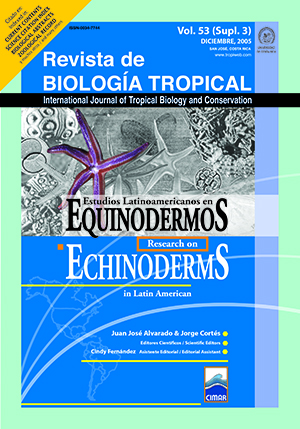Abstract
Larvae and postlarvae production of the green-white sea urchin Lytechinus variegatus (Echinodermata: Echinoidea) in culture conditions. We evaluated the biological feasibility of massive larvae and postlarvae production of the Caribbean green-white urchin Lytechinus variegatus. Experiments were designed to choose the initial larval density and microalgae diets under culture, to study metamorphosis, postlarval and juvenile growth. Massive production of competent larvae 650 μm long at 12-13 days is possible using larval densities of 0.25 to 1 larva/ml. The microalgae Rhodomonas sp. was suitable for the optimization of larval growth and survival. Metamorphosis of 100% of the larvae can be induced with films of bentic diatoms (Navicula sp. and Amphora sp.), after 96 h; however, diatoms are not adequate for postlarval development and a food supply of Ulva lactuta is necessary for proper growth. For juveniles, a diet of macroalgae (U. lactuta) and/or commercial marine shrimp culture pellet food is enough for growth, but the best results were obtained with shrimp or U. lactuta used alone (85-86%, against 46% with the mixed diet). We recommend future experiments on nutritional requirements to optimize growth of these and subsequent stages. Rev. Biol. Trop. 53(Suppl. 3): 319-328. Epub 2006 Jan 30.References
Bustos, E. & S. Olave. 2001. Manual: El cultivo del erizo Loxechinus albus. División de Acuicultura, Instituto de Fomento Pesquero. 23 p.
Bustos, E., C. Godoy, S. Olave & R. Troncoso. 1991. Desarrollo de técnicas de producción de semillas y repoblación de recursos bentónicos. Instituto de Fomento Pesquero. PNUD. Chile, 60 p.
Cameron, R.A. & R.T. Hinegardner. 1974. Initiation of metamorphosis in laboratory cultured sea urchins. Biol. Bull. 146 : 335-342.
Carpizo-Ituarte, E., A. Salas-Garza & G. Pares-Sierra. 2002. Inducción de la metamorfosis con KCl en tres especies de erizos de mar y sus implicaciones en la producción de juveniles. Cienc. Mar. 28:157-166.
Fonseca, J. 2001. Efecto de seis dietas microalgales en el desarrollo larvario, metamorfosis y obtención de juveniles del erizo morado Strongylocentrotus purpuratus (Stimpson). Tesis de Maestría, Universidad Autónoma de Baja California, Ensenada, México. 83 p.
George, S. B., J.M. Lawrece, A.L. Lawrence, J. Smiley & L. Plank. 2001. Carotenoids in the adult diet enhance egg and juvenile production in the sea urchin Lytechinus variegatus. Aquaculture 199: 353–369.
Gómez, A. 1999. Los recursos marinos renovables del Estado Nueva Esparta, Venezuela: Biología y pesca de las especies comerciales. Tomo I Invertebrados y algas. 208 p.
Gómez, A. 2002. Abundancia de erizo Lytechinus variegatus (Lamarck) en la costa norte, este y oeste de la Isla de Margarita (Venezuela). Acta Científica Venezolana 53: 15-20.
González, L. P., J.C. Castilla & C. Guisado. 1987. Effect of larval diet and rearing temperature on metamorphosis and juvenile survival of the edible sea urchin Loxechinus albus (Molina, 1782) (Echinoidea: Echinidae). J. Shellfish Res. 6: 109-115.
Grosjean, P., C. Spirlet, P. Gosselin, D. Vaitilingon, & M. Jangoux. 1998. Land-based, closed-cycle echinoculture of Paracentrouts lividus (Lamarck) (Echinoidea: Echinodermata): A long-term experiment at pilot scale. J. Shellfish Res. 17: 1523-1531.
Strathmann, M.F. 1987. Reproduction and development of marine invertebrates of the northen Pacific coast. University of Washington Press. Seattle, Washington. 670 p.
Hagen, N.T. 1996. Echinoculture: from fishery enhancement to closed cycle cultivation. World Aquaculture 27: 7-19.
Hinegardner, R.T. 1969. Growth and development of laboratory sea urchin. Biol. Bull. 137: 465-475.
Keesing, J. & K.C. Hall. 1998. Review of harvests and status of word sea urchin fisheries points to opportunities for aquaculture. J. Shellfish Res. 17: 1597-1604.
Kelly, M.S., A.J. Hunter, C.L. Scholfield & J.D. Mckenzie. 2000. Morphology and survivorship of larval Psammechinus miliaris (Gmelin) (Echinodermata: Echinoidea) in response to varying food quantity and quality. Aquaculture 183: 223-240.
Keough, M.J. & P.T. Raimondi. 1995. Response of settling invertebrate larvae to bioorganic film: effects of different types of films. J. Exp. Mar. Biol. Ecol. 185: 235-253.
Klinger, T., J. Lawrence & A. Lawrence. 1994. Digestive characteristics of the sea urchin Lytechinus variegatus (Lamarck) (Echinodermata:Echinoidea) fed prepared feeds. J. World Aquacul. Soc. 25: 489-496.
Lawrence, J.M., R. Plank & I. Lawrence. 2002. The effect of dietary carotenoids on gonad production and carotenoid profiles in the sea urchin Lytechinus variegatus. J. World Aquacul. Soc. 33: 127-137.
McEdward, L. & J. Herrera. 1999. Body form and skeletal morphometrics during larval development of the sea urchin Lythechinus variegatus Lamarck. J. Exp. Mar. Biol. Ecol. 232: 151-176.
Moore, H.B., T. Jutare, J.C. Bauer & J.A. Jones. 1963. The Biology of Lytechinus variegatus Bull. Mar. Sci. Gulf and Caribbean 13: 23-53.
Strathmann, M.F. 1987. “Phylum Echinodermata, class Echinoidea” In: Reproduction and development of marine invertebrates of the northen Pacific coast. University of Washington Press. Seattle, Washington. 670 p.
Watts, S.A., M.S. Vickery, M. Becerro, B.D. Wallace & J.M. Lawrence. 2001. Problems associated with settlement, metamorphosis end post-metamorphic growth of Lythechinus variegatus in culture. Aquaculture- 2001. Word Aquaculture Society University Baton Rouge LA-USA. 127 p.
Wiencek, R.M. & M. Fletcher. 1995. Bacterial adhesion to hydroxil-an methyl-terminated alkanethiol selfassembled monolayers. J. Bacteriol. 177: 1959-1966.
##plugins.facebook.comentarios##

This work is licensed under a Creative Commons Attribution 4.0 International License.
Copyright (c) 2005 Revista de Biología Tropical






